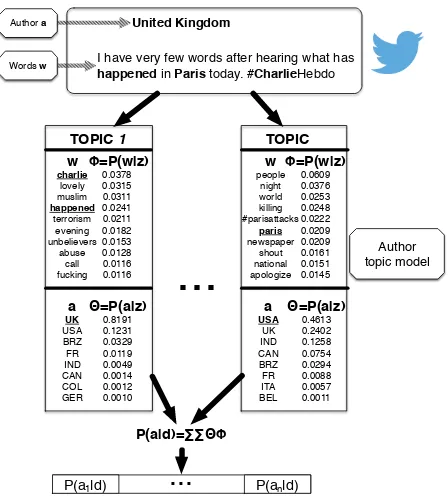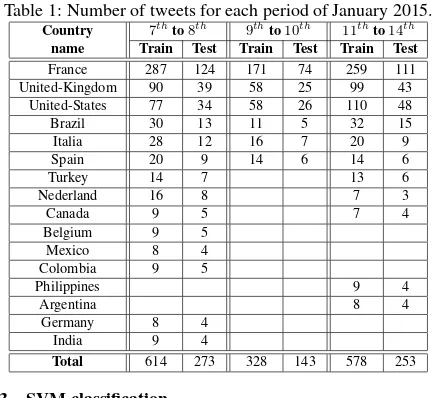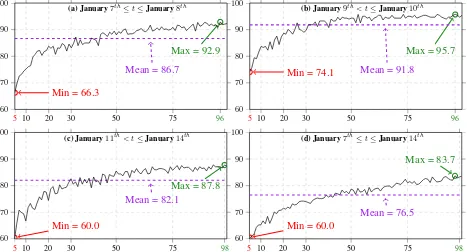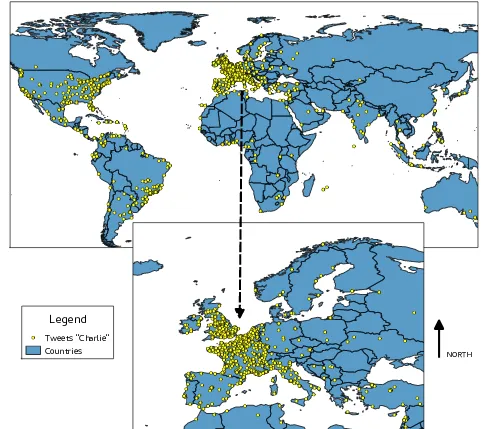A TOPIC MODELING BASED REPRESENTATION TO DETECT TWEET LOCATIONS.
EXAMPLE OF THE EVENT ”JE SUIS CHARLIE”
∗
Mohamed Morchida, Didier Josselinc,a, Yonathan Portillaa,b, Richard Dufoura, Eitan Altmanb,a, Georges Linar`esa
a
Laboratoire Informatique d’Avignon (LIA), University of Avignon (France) -{firstname.lastname}@univ-avignon.fr
bINRIA, B.P 93, 06902 Sophia Antipolis Cedex (France) -{firstname.lastname}@inria.fr
c
UMR ESPACE 7300, CNRS, UNSA (France)
KEY WORDS:Tweets location, Topic modeling, Author topic model, Twitter
ABSTRACT:
Social Networks became a major actor in information propagation. Using the Twitter popular platform, mobile users post or relay messages from different locations. The tweet content, meaning and location, show how an event-such as the bursty one ”JeSuisCharlie”, happened in France in January 2015, is comprehended in different countries. This research aims at clustering the tweets according to the co-occurrence of their terms, including the country, and forecasting the probable country of a non-located tweet, knowing its content. First, we present the process of collecting a large quantity of data from the Twitter website. We finally have a set of 2,189 located tweets about “Charlie”, from the 7th to the 14th of January. We describe an original method adapted from the Author-Topic (AT) model based on the Latent Dirichlet Allocation (LDA) method. We define an homogeneous space containing both lexical content (words) and spatial information (country). During a training process on a part of the sample, we provide a set of clusters (topics) based on statistical relations between lexical and spatial terms. During a clustering task, we evaluate the method effectiveness on the rest of the sample that reaches up to 95% of good assignment. It shows that our model is pertinent to foresee tweet location after a learning process.
1. INTRODUCTION AND STATE OF THE ART
The exponential growth of available data on the Web enables users to access a large quantity of information. Micro-blogging platforms evolve in the same way, offering an easy way to dis-seminate ideas, opinions or common facts under the form of short text messages. Depending on the sharing platform used, the size of these messages can be limited to a maximum number of words or characters. Although Twitter is a recent information-sharing model, it has been widely studied. Many works have focused on various aspects of Twitter, such as social impact (Kwak et al., 2010), event detection (Zhao et al., 2011), user influence (Cha et al., 2010), sentiment analysis (Tumasjan et al., 2010), hashtag analysis (Huang et al., 2010), or theme classification (Morchid et al., 2014a).
The aim of the proposed approach is to locate a given tweet by using the tweet content (a set of words). Nonetheless, the Twitter service does not allow to send messages whose size exceeds 140 characters. This constraint causes the use of a particular vocab-ulary that is often unusual, noisy, full of new words, including misspelled or even truncated words (Choudhury et al., 2007). In-deed, the goal of these messages is to include a lot of informa-tion with a small number of characters. Thus, it may be difficult to understand the meaning of a short text message (STM) with only the tweet content (words). Several approaches have been proposed to represent the tweet content. The classical bag-of-words approach (Salton and Buckley, 1988) is usually used for text document representation in the context of keyword extrac-tion. This method estimates the Term Frequency-Inverse Doc-ument Frequency (TF-IDF) of the docDoc-ument terms. Although this unsupervised approach is effective for a large collection of documents, it seems unusable in the particular case of short mes-sages since most of the words occur only once (hapax legom-ena (Baayen, 1998)). Other approaches propose to consider the document as a mixture of latent topics to work around segments of errors. These methods build a higher-level representation of
∗Corresponding author
the document in a topic space. All these methods are commonly used in the Information Retrieval (IR) field. They consider doc-uments as a bag-of-words without taking account of the words order. Nevertheless, they demonstrated their performance on var-ious tasks. Several approaches considered a text document as a mixture of latent topics. These methods, such as Latent Seman-tic Analysis (LSA) (Deerwester et al., 1990, Bellegarda, 1997), Probabilistic LSA (PLSA) (Hofmann, 1999) or Latent Dirichlet Allocation (LDA) (Blei et al., 2003), build a higher-level repre-sentation of the document in a topic space. Document is then considered as a bag-of-words (Salton, 1989) where the word or-der is not taken into account. These methods have demonstrated their performance on various tasks, such as sentence (Bellegarda, 2000) or keyword (Suzuki et al., 1998) extraction. LDA is a gen-erative model of statistics which considers a document, seen as a bag-of-words, as a mixture probability of latent topics. In op-position to a multinomial mixture model, LDA considers that a theme is associated with each occurrence of a word composing the document, rather than associating a topic with the complete document.
words into the tweet and the location, considered as a latent re-lation. From this model, a vector representation in a continuous space is built for each tweet. Then, a supervised classification ap-proach, based on Support Vector Machines (SVM) (Vapnik and Lerner, 1963) is applied. For mathematical and methodological details, see (Morchid et al., 2014b).
Another complementary dimension of the tackled problem is geo-graphical. Indeed, much information about located events spread over the territory in the world from their original location to other countries. An event can be considered as a flow that depicts a spatial buzz. It is then interesting to study this kind of process to assess where the impact of this specific event was the strongest and how it evolves in time. However, Twitter does not provide the entire data sets of tweets, that would be anyway unusable due to the too large quantity of data. It is expected that Twitter publishes 0.01 p.c. of located tweets from the whole data set. Moreover, it is not proved that the resulting sample is representative of all the tweets exchanged. At least, it is what we observed regarding the tweets about the ”Charlie” event.
I have very few words after hearing what has happened in Paris today. #CharlieHebdo
...
Figure 1: Example of a tweetd mapped into an author topic
model of sizeT.
2. AUTHOR-TOPIC MODELING FOR TWEETS
LOCATION
Short text messages from a sharing platform such as Twitter con-tain many errors due to the constraint of the tweets size. An el-egant way to tackle these errors is to map tweets in a thematic space in order to abstract the document content.
To go beyond the LDA limit, the Author-topic (AT) model (Rosen-Zvi et al., 2004) was proposed. The AT model links both authors (here, the country) and documents content (words contained in a tweet). Next sections describe the AT model. An example of a tweet mapped into an AT model is presented in Figure 1, while Figure 2 represents the AT model into its plate notation. For each wordwcontained in a documentd, an authorais uniformly cho-sen at random. Then, a topiczis chosen from a distribution over topics specific to that author, and the word is generated from the chosen topic.
Figure 2: Generative model in plate notation of the Author-Topic (AT) model.
In our application, a documentdis a short text message from the sharing platform Twitter and a country is considered as an au-thor. Thus, each tweetdis composed with a set of wordswand a countrya. In this model,xindicates the country providing a given word, chosen fromad. Each country is associated with a
distribution over topics (θ), chosen from a symmetric Dirichlet prior (−→α), and a weighted mixture to select a topicz. A word is then generated according to the distributionφcorresponding to the topicz. This distributionφis drawn from a Dirichlet (−→β). The parametersφandθare estimated from a straightforward al-gorithm based on the Gibbs Sampling (Rosen-Zvi et al., 2004) such as the LDA hyper-parameters estimation method. Figure 1
shows the mapping process of an unseen tweetdfrom the
val-idation set into an author topic space of sizeT. Each tweetd is consists of a words setwand a label (country)aconsidered as the author in the AT model. Thus, this model allows to code statistical dependencies between the tweet content (wordsw) and label (countrya) through the distribution of the latent topics in the tweet.
The generative process we use corresponds to the hierarchical Bayesian model shown, using a plate notation, in the Figure 2 (a). Several techniques, such as Variational Methods (Blei et al., 2003), Expectation-propagation (Minka and Lafferty, 2002) or Gibbs Sampling (Griffiths and Steyvers, 2004), were proposed to estimate the parameters describing a hidden space. Gibbs Sam-pling is a special case of Markov-chain Monte Carlo (MCMC) (Ge-man and Ge(Ge-man, 1984). It gives a simple algorithm for approxi-mate inference in high-dimensional models such as AT-model (Rosen-Zvi et al., 2004). This overcomes the difficulty to directly and exactly estimate parameters that maximize the likelihood of the whole data collection defined as:
P(W|−→α ,−→β) = Y
w∈W
P(−→w|−→α ,−→β) (1)
for the whole data collectionW knowing the Dirichlet
parame-ters−→α and−→β.
To estimate LDA, the Gibbs Sampling was firstly reported in (Grif-fiths and Steyvers, 2004). A more comprehensive description of this method can be found in (?). One can refer to these papers for a better understanding of this sampling technique. This method is used both to estimate the LDA parameters and to infer an unseen dialogue with a hidden space ofTtopics. Gibbs Sampling allows us to estimate the AT model parameters, in order to represent an unseen tweetdwith therth
author topic space of sizeT, and to obtain a feature vectorVa
r k
d =P(ak|d)of the topic
T. Thekth(1≤k≤A) feature is:
whereAis the number of countries (authors) in our case;θr
j,ak=
P(ak|zr,j)is the probability of a countryakto be generated by
the topiczr,j (1 ≤ j ≤ T) in therthtopic space of sizeT.
φr
j,i =P(wi|zr,j)is the probability of the wordwi(Ndis the
vocabulary size ofd) to be generated by the topiczr,j.
3. EXPERIMENTAL PROTOCOL
We propose to evaluate the proposed approach in the application framework of a Twitter corpus. This corpus, presented in Table 1, is composed of a set of tweets from different countries. Its was constituted during the period were the event ”Charlie” occurred, corresponding to about a week in January 2015. We developed a dedicated tool able to automatically capture online the tweets emitted all over the world. A second process permitted to filter the tweets, keeping only the ones that concern the event ”Char-lie” and that where located in space. Using these data, a classi-fication approach based on Support Vector Machines (SVM) was performed to find out the most likely country of a given tweet. Next sections describe the data set, the author-topic model and the SVM classification method.
3.1 Tweets dataset
Concerning the event ”Charlie”, tweets are automatically labeled
with one of the16countries presented in Table 1 which sums
up the corpus obtained in the sample available from the Twit-ter servers. This data set is split in three parts depending on the tweets emission dayδin 2015:
• January7th≤δ≤
We used1,520tweets for the training phase of the AT models and669for the validation (testing) phase which corresponds to a corpus of2,189tweets for the whole16countries (roughly137
tweets for each country).
3.2 Author-Topic model
The number of topics contained in the AT model strongly influ-ences the quality (called perplexity) of this model. Indeed, an AT model with only few topics will be more general than a one with a large number of classes (granularity of the model). For a
sake comparison, a set of100AT models of sizeT was learnt
(5≤T ≤105).
Table 1: Number of tweets for each period of January 2015.
Country 7th name Train Test Train Test Train Test France 287 124 171 74 259 111 United-Kingdom 90 39 58 25 99 43 United-States 77 34 58 26 110 48 Brazil 30 13 11 5 32 15
Total 614 273 328 143 578 253
3.3 SVM classification
As the classification of tweets requires a multi-class classifier,
the SVMone-against-one method is chosen with a linear
ker-nel. This method gives a better accuracy than the one-against-rest(Yuan et al., 2012). In this multi-class problem,Adenotes the number of countries andti, i= 1, . . . , A. A binary classifier
is used with a linear kernel for every pair of distinct country. As a result, binary classifiersA(A−1)/2are constructed all together. The binary classifierCi,jis trained from example data whereti
is a positive class andtja negative one (i6=j).
For a vector representation of an unseen tweetd(Va r k
d for an AT
representation), ifCi,jmeans thatdis in the countryti, then the
vote for the classtiis incremented of one. Otherwise, the vote for
the countrytjis increased by one. After the vote of all classifiers,
the tweetdis assigned to the country having the highest number of votes.
4. RESULTS
A major event named ”Je suis Charlie” happened in Paris in Jan-uary, 7th
to 14th
2015 and immediately appeared on Internet sharing platforms. Figure 3 shows the accuracy of this bursty event (percentage of countries found) obtained during the country location task presented above, for different time periods (7th→
8thJanuary 2015 (a),9th → 10th January 2015 (b),11th →
14th
January 2015 (c) and7th→14th
January 2015 (d).
The first remark regarding the curves in Figure 3, is that the higher the number of topics of the AT model, the better the loca-tion accuracy. Indeed, regardless the time period of tweet emis-sions, the best accuracy is reached with an AT model of size96or
98topics. Contrariwise, the worst results are observed with AT models having a small number of topics (5).
The approach proposed to automatically locate a tweet obtains very promising results (more than95%for the9th→10th
Jan-uary 2015 time period as shown in Figure 3-(b), Figure 3-(d) pre-senting the results observed regardless the epoch (7th → 14th
January 2015)). In a same manner, one can easily notice that the more precise the AT model (high number of topics), the higher the accuracy. A topic model with a thin granularity allows us to better characterize the meaning of a given message.
Finally, we can point out that the best result is reached during the
9th→10th
5 10 20 30 50 75 96 60
70 80 90 100
Max = 92.9
Min = 66.3
Mean = 86.7
(a) January7th
≤t≤January8th
5 10 20 30 50 75 96
60 70 80 90 100
Max = 95.7
Min = 74.1
Mean = 91.8
(b) January9th
< t≤January10th
5 10 20 30 50 75 98
60 70 80 90 100
Max = 87.8
Min = 60.0
Mean = 82.1
(c) January11th
< t≤January14th
5 10 20 30 50 75 98
60 70 80 90 100
Max = 83.7
Min = 60.0
Mean = 76.5
(d) January7th
≤t≤January14th
Figure 3: Country classification accuracies (%) using various author topic-based representations on the test sets with different epochs. X-axis represents the numbernof classes contained into the topic space (5≤n≤100).
5. CONCLUSION
In this paper, we present an efficient way to deal with short text messages from Internet micro-blogging platforms which are highly error prone. The approach seeks to map a tweet into a high-level representation using the Author-topic (AT) model that takes into consideration all information contained in a tweet: the content itself (words), the label (country) and the relation between the distribution of words in the tweet and its location, considered as a latent relation. A high-level representation allows us to obtain very promising results during the identification of the country. Experiments conducted on a Twitter corpus showed the effective-ness of the proposed AT model with an accuracy reached of more than 95%. However, these results are based on the peculiar words of significantly different languages and it does not give any se-mantic information on the way the Charlie event was perceived by the population from these countries. This could be an addi-tional interesting approach to develop, especially if it is linked to a map of tweets, to observe how such a worldwide event makes a buzz in space and time.
ACKNOWLEDGEMENTS
This work has been partially funded by the ContNomina project supported by the French National Research Agency (ANR) under contract ANR-12-BS02-0009.
REFERENCES
Baayen, A. R. R. H., 1998. Aviating among the hapax legomena: Morphological grammaticalisation in current british newspaper english. Explorations in corpus linguistics (23), pp. 181.
Bellegarda, J., 1997. A latent semantic analysis framework for large-span language modeling. In: Fifth European Conference on Speech Communication and Technology.
Bellegarda, J. R., 2000. Exploiting latent semantic information in statistical language modeling. Proceedings of the IEEE 88(8), pp. 1279–1296.
Blei, D., Ng, A. and Jordan, M., 2003. Latent dirichlet allocation. The Journal of Machine Learning Research 3, pp. 993–1022.
Cha, M., Haddadi, H., Benevenuto, F. and Gummadi, K. P., 2010. Measuring user influence in twitter: The million follower fallacy. In: Intern. Conference on Weblogs and Social Media (ICWSM).
Choudhury, M., Saraf, R., Jain, V., Sarkar, S. and Basu, A., 2007. Investigation and modeling of the structure of texting language. In: IJCAI, pp. 63–70.
Deerwester, S., Dumais, S., Furnas, G., Landauer, T. and Harsh-man, R., 1990. Indexing by latent semantic analysis. Journal of the American society for information science 41(6), pp. 391–407.
Geman, S. and Geman, D., 1984. Stochastic relaxation, gibbs dis-tributions, and the bayesian restoration of images. IEEE Transac-tions on Pattern Analysis and Machine Intelligence (6), pp. 721– 741.
Griffiths, T. L. and Steyvers, M., 2004. Finding scientific topics. Proceedings of the National academy of Sciences of the United States of America 101(Suppl 1), pp. 5228–5235.
Hofmann, T., 1999. Probabilistic latent semantic analysis. In: Proc. of Uncertainty in Artificial Intelligence, UAI’99, Citeseer, p. 21.
Huang, J., Thornton, K. M. and Efthimiadis, E. N., 2010. Con-versational tagging in twitter. In: Proceedings of the 21st ACM conference on Hypertext and hypermedia, ACM, pp. 173–178.
Tweets "Charlie" Countries
Legend
NORTH
Minka, T. and Lafferty, J., 2002. Expectation-propagation for the generative aspect model. In: Conference on Uncertainty in arti-ficial intelligence, Morgan Kaufmann Publishers Inc., pp. 352– 359.
Morchid, M., Dufour, R. and Linar`es, G., 2014a. A LDA-based topic classification approach from highly imperfect automatic transcriptions. In: LREC’14.
Morchid, M., Dufour, R., Bouallegue, M. and Linar`es, G., 2014b. Author-topic based representation of call-center conversations. In: International Spoken Language Technology Workshop (SLT).
Rosen-Zvi, M., Griffiths, T., Steyvers, M. and Smyth, P., 2004. The author-topic model for authors and documents. In: UAI’04, pp. 487–494.
Salton, G., 1989. Automatic text processing: the transformation. Analysis and Retrieval of Information by Computer.
Salton, G. and Buckley, C., 1988. Term-weighting approaches in automatic text retrieval* 1. Information processing & manage-ment 24(5), pp. 513–523.
Suzuki, Y., Fukumoto, F. and Sekiguchi, Y., 1998. Keyword ex-traction using term-domain interdependence for dictation of ra-dio news. In: 17th international conference on Computational linguistics, Vol. 2, ACL, pp. 1272–1276.
Tumasjan, A., Sprenger, T. O., Sandner, P. G. and Welpe, I. M., 2010. Predicting elections with Twitter: What 140 characters reveal about political sentiment. In: ICWSM, pp. 178–185.
Vapnik, V. and Lerner, A., 1963. Pattern recognition using gen-eralized portrait method. Automation and Remote Control 24, pp. 774–780.
Yuan, G.-X., Ho, C.-H. and Lin, C.-J., 2012. Recent advances of large-scale linear classification. Proceedings of the IEEE 100(9), pp. 2584–2603.



